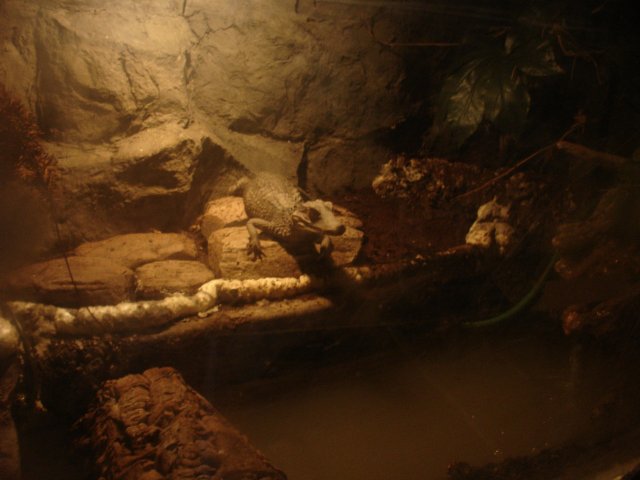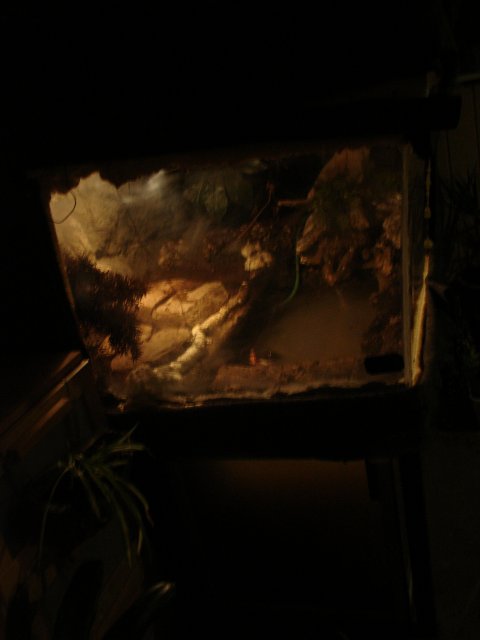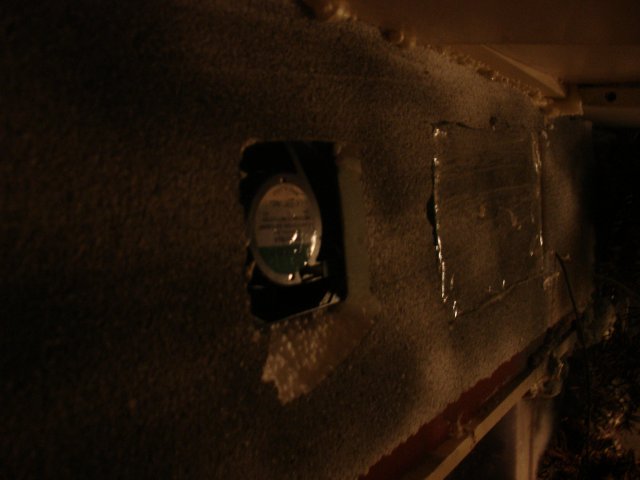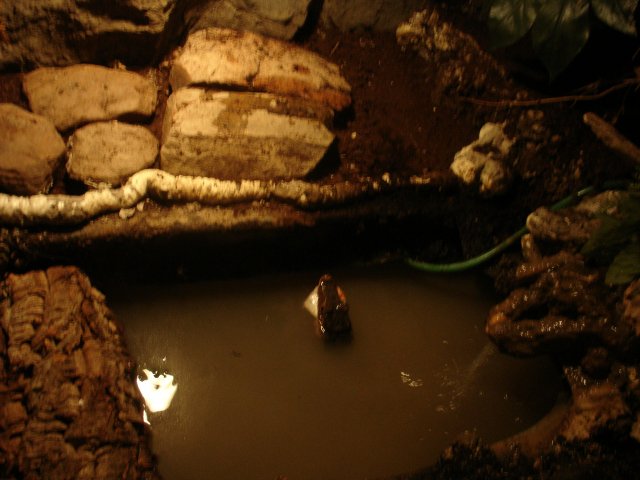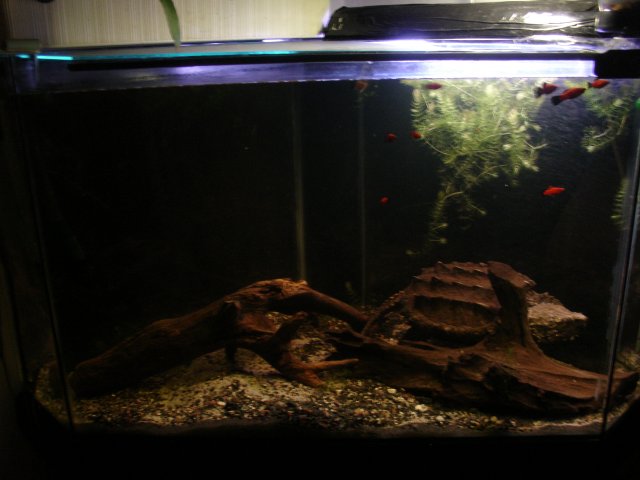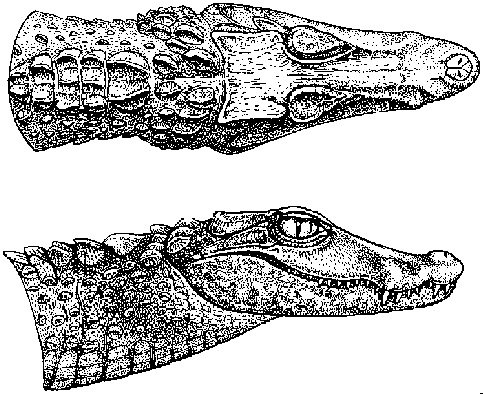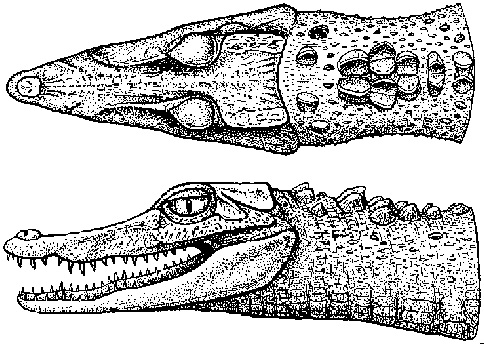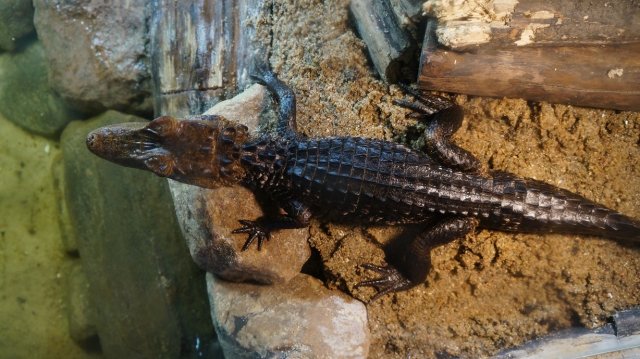.....a few more belated thoughts, diet for starters, MY routine was a combination of dusted crickets, lots of fish, mainly trout (just cuz I always have tons of it), sliced and diced chicken cutlets ( small enough to swallow in 1 bite, so the dust doesn't get wasted by thrashing in the water; hemostats of course), mice or rats at least 2x a week, fed concentrations of reptomin and high-protein cichlid pellets or high-end dogfood - I like Canindae, Verus and Science Diet if you can keep them overnight or cycle a new one in the separate tank/cage with food in it. I said separate cuz you don't want a rat to take a bite out of a caiman that's not aware, or just that it's Rule #1 never leave an unattended rodent in a reptile's cage with it. Also, try to get it to eat reptomin as young as possible....pellet food will mellow the aggression and make life easier for both of you. Hikari Cichlid Bio-gold would be great for them too. Protein, protein, protein.
If you haven't heard of them, "Goliath Worms", a trade name for CAPTIVE BRED Tomato or Tobacco Horn Worms ( isay captive bred cuz they eat poisonous plants in the wild - tomato & especially tobacco are toxic to reptiles, dogs, and other animals) have been made readily available in the per trade. Find a reputable dealer, order them by phone, online or purchase them at your Local Reptile Expositions. If you tell me what part of the world you are in I can possibly find someone in your area who has/can find them. 1 Full grown Goliath is about the equivalent of 1-2 DOZEN crickets, and raised and bred healthy lizards on them for the past few years. They are very healthy, no chitinous outershell and add amazing color to your animal. They are fed a mixture of wheat, protein whey, honey bran combination from birth.
Also, after some careful thought if you want to breed, you need to make it bigger. I would push a pair of Curvier's if there was a dry land space with a few hundred pounds of sand for the eggs, but to house a 5.5' male and a 4.5' female, you'll have to expand and make the land area at least the size of the water area. Other options might be building an outdoor compound for them and keeping them outside from start of breeding season until maybe the end of September. In this manner, the light cycle will be natural and nature will tell them when it's time to mate. If you are liking this input, I can walk you through breeding, but I doubt I will have to help much, you seem like a natural tbh. If you aren't liking it, im sorry, I saw you asked for input and this is what I thought of lol Thinking is fun.
Btw, what is your ambient and basking temperatures? They will also appreciate a good misting daily....it rains everyday mostly in the Amazon, so as dumb as it sounds, mist a reptile who spends 75% of it's life in the water
Have you considered a medium-sized armored catfish approximately the same size as the Caiman? Not something with a powerful bite, just something peaceful that will get fairly large (3-4 '), maybe a SA Redtail to keep the tank clean and add diversity and entertainment for the Caiman? You could breed Jaguar Cichlids in there if you can keep the ammonia/nitrates down, and section off a 40-50 gallon area for them to breed in, while Caiman proofing the entrance by a series of caves barely big enough for the parent fish to swim through. Pacus would be an excellent choice as well, and he would have a difficult time catching African Mbuna if at all. Finally last but not least, the most common animal kept with crocodilians *drumroll* - yup, u guessed it - turtles. Preferably herbivores, but St. Augustine Alligator Farm has a few Florida and Alligator snapppers in their Intermediate-sized Gator habitat. I wouldn't risk injury to my croc, but they certainly had them together last time I was there.
Have fun.
If you haven't heard of them, "Goliath Worms", a trade name for CAPTIVE BRED Tomato or Tobacco Horn Worms ( isay captive bred cuz they eat poisonous plants in the wild - tomato & especially tobacco are toxic to reptiles, dogs, and other animals) have been made readily available in the per trade. Find a reputable dealer, order them by phone, online or purchase them at your Local Reptile Expositions. If you tell me what part of the world you are in I can possibly find someone in your area who has/can find them. 1 Full grown Goliath is about the equivalent of 1-2 DOZEN crickets, and raised and bred healthy lizards on them for the past few years. They are very healthy, no chitinous outershell and add amazing color to your animal. They are fed a mixture of wheat, protein whey, honey bran combination from birth.
Also, after some careful thought if you want to breed, you need to make it bigger. I would push a pair of Curvier's if there was a dry land space with a few hundred pounds of sand for the eggs, but to house a 5.5' male and a 4.5' female, you'll have to expand and make the land area at least the size of the water area. Other options might be building an outdoor compound for them and keeping them outside from start of breeding season until maybe the end of September. In this manner, the light cycle will be natural and nature will tell them when it's time to mate. If you are liking this input, I can walk you through breeding, but I doubt I will have to help much, you seem like a natural tbh. If you aren't liking it, im sorry, I saw you asked for input and this is what I thought of lol Thinking is fun.
Btw, what is your ambient and basking temperatures? They will also appreciate a good misting daily....it rains everyday mostly in the Amazon, so as dumb as it sounds, mist a reptile who spends 75% of it's life in the water
Have you considered a medium-sized armored catfish approximately the same size as the Caiman? Not something with a powerful bite, just something peaceful that will get fairly large (3-4 '), maybe a SA Redtail to keep the tank clean and add diversity and entertainment for the Caiman? You could breed Jaguar Cichlids in there if you can keep the ammonia/nitrates down, and section off a 40-50 gallon area for them to breed in, while Caiman proofing the entrance by a series of caves barely big enough for the parent fish to swim through. Pacus would be an excellent choice as well, and he would have a difficult time catching African Mbuna if at all. Finally last but not least, the most common animal kept with crocodilians *drumroll* - yup, u guessed it - turtles. Preferably herbivores, but St. Augustine Alligator Farm has a few Florida and Alligator snapppers in their Intermediate-sized Gator habitat. I wouldn't risk injury to my croc, but they certainly had them together last time I was there.
Have fun.
Last edited:


